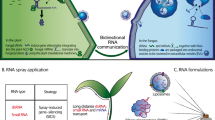Abstract
One mechanism by which plants defend themselves against insect herbivores is the production of plant proteinase inhibitors, which can inhibit digestion in the midgut, thus affecting growth and survival. In this work, the effect of Colorado potato beetle (CPB) [Leptinotarsa decemlineata (Say)] regurgitant on Solanum lycopersicum defenses was investigated. When regurgitant from fourth-instar CPB was applied to wounded S. lycopersicum leaves, the wound-induced transcripts for the proteinase inhibitors pin1 and pin2 were reduced. Boiling the regurgitant abolished its ability to reduce the pin transcripts. Ultrafiltration of the regurgitant demonstrated that it contained a component between 10 and 30 kDa molecular weight that inhibited wound-induced pin1 and pin2 expression, suggesting that it may be a protein. This may represent a mechanism that the CPB has evolved to elude the plant’s induced response to infestation.




Similar content being viewed by others
References
Albourn, H. T., Turlings, T. C. J., Jones, T. H., Stenhagen, G., Loughrin, J. H., and Tumlinson, J. H. 1997. An elicitor of plant volatiles from beet armyworm oral secretions. Science 276:945–949.
Bolter, C. J. 1993. Methyl jasmonate induces papain inhibitors in tomato leaves. Plant Physiol. 103:1347–1353.
Bolter, C. J., and Jongsma, M. A. 1995. Colorado potato beetles (Leptinotarsa decemlineata) adapt to proteinase inhibitors induced in potato leaves by methyl jasmonate. J. Insect Physiol. 41:1071–1078.
Chang, S., Puryear, J., and Cairney, J. 1993. A simple and efficient method for isolating RNA from pine trees. Plant Mol. Biol. Rep. 11:113–116.
Eichenseer, H., Mathews, M. C., Bi, J. L., Murphy, J. B., and Felton, G. W. 1999. Salivary glucose oxidase: multifunctional roles for Helicoverpa zea. Arch. Insect Biochem. Physiol. 42:99–109.
Halitschke, R., Schittko, U., Pohnert, G., Boland, W., and Baldwin, I. T. 2001. Molecular interactions between the specialist herbivore Manduca sexta (Lepidoptera, Sphingidae) and its natural host Nicotiana attenuata III. Fatty acid–amino acid conjugates in herbivore oral secretions are necessary and sufficient for herbivore-specific plant responses. Plant Physiol. 125:711–717.
Halitschke, R., Gase, K., Hui, D., Schmidt, D. D., and Baldwin, I. T. 2003. Molecular interactions between the specialist herbivore Manduca sexta (Lepidoptera, Sphingidae) and its natural host Nicotiana attenuata. VI. Microarray analysis reveals that most herbivore-specific transcriptional changes are mediated by fatty acid–amino acid conjugates. Plant Physiol. 131:1894–1902.
Kruzmane, D., Jankevica, L., and Ievinsh, G. 2002. Effect of regurgitant from Leptinotarsa decemlineata on wound responses in Solanum tuberosum and Phaseolus vulgaris. Physiol. Plant. 115:577–584.
Mattiacci, L., Dicke, M., and Posthumus, M. A. 1995. Beta-glucosidase: an elicitor of herbivore-induced plant odor that attracts host-searching parasitic wasps. Proc. Natl. Acad. Sci. U. S. A. 92:2036–2040.
Mithofer, A., Wanner, G., and Boland, W. 2005. Effects of feeding Spodoptera littoralis on lima bean leaves. II. Continuous mechanical wounding resembling insect feeding is sufficient to elicit herbivory-related volatile emission. Plant Physiol. 137:1160–1168.
Musser, R. O., Hum-Musser, S. M., Eichenseer, H., Peiffer, M., Ervin, G. Murphy, J. B., and Felton, G. W. 2002. Caterpillar saliva beats plant defences. Nature 416:599–600.
Musser, R. O., Cipollini, D. F., Hum-Musser, S. M., Williams, S. A., Brown, J. K., and Felton, G. W. 2005. Evidence that the caterpillar salivary enzyme glucose oxidase provides herbivore offense in Solanaceous plants. Arch. Insect Biochem. Physiol. 58:128–137.
Novillo, C., Castaner, P., and Ortego, F. 1997. Characterization and distribution of chymotrypsin-like and other digestive proteases in Colorado potato beetle larvae. Arch. Insect Biochem. Physiol. 36:181–201.
Pare, P. W., Alborn, H. T., and Tumlinson, J. H. 1998. Concerted biosynthesis of an insect elicitor of plant volatiles. Proc. Natl. Acad. Sci. U. S. A. 95:13971–13975.
Plunkett, G., Senear, D. F., Zuroske, G., and Ryan, C. A. 1982. Proteinase inhibitors I and II from leaves of wounded tomato plants: purification and properties. Arch. Biochem. Biophys. 213:463–472.
Pohnert, G., Jung, V., Haukioja, E., Lempa, K., and Boland, W. 1999. New fatty acid amides from regurgitant of lepitopteran (Noctuidae, Geometridae) caterpillars. Tetrahedron 55:11275–11280.
Ryan, C. A. 2000. The systemin signaling pathway: differential activation of plant defensive genes. Biochim. Biophys. Acta. 1477:112–121.
Sambrook, J., Fritsch, E. F., and Maniatis, T. 1989. Molecular Cloning: A Laboratory Manual, Second Edition. Cold Spring Harbor Laboratory, Cold Spring Harbor.
Schilmiller A. L., and Howe, G. A. 2005. Systemic signaling in the wound response. Curr. Opin. Plant Biol. 8:369–377.
Schittko, U., Hermsmeier, D., and Baldwin, I. T. 2001. Molecular interactions between the specialist herbivore Manduca sexta (Lepidoptera, Sphingidae) and its natural host Nicotiana attenuata. II Accumulation of plant mRNAs in response to insect-derived cues. Plant Physiol. 125:701–710.
Weissbecker, B., Van Loon, J. J. A., and Dicke, M. 1999. Electroantennogram responses of a predator Perillus bioculatus and its prey Leptinotarsa decemlineata, to plant volatiles. J. Chem. Ecol. 25:2313–2325.
Wolfson, J. L. and Murdock, L. L. 1987. Suppression of larval Colorado potato beetle growth and development by digestive proteinase inhibitors. Entomol. Exp. Appl. 44:235–240.
Acknowledgement
We are indebted to R. Bennett (USDA Agricultural Research Service) for care and handling of tomato plants and the CPB colony. Mention of a trademark or proprietary product does not constitute a guarantee or warranty of the product by the USDA and does not imply its approval to the exclusion of other products that may also be suitable.
Author information
Authors and Affiliations
Corresponding author
Rights and permissions
About this article
Cite this article
Lawrence, S.D., Novak, N.G. & Blackburn, M.B. Inhibition of Proteinase Inhibitor Transcripts by Leptinotarsa decemlineata Regurgitant in Solanum lycopersicum . J Chem Ecol 33, 1041–1048 (2007). https://doi.org/10.1007/s10886-007-9285-2
Received:
Revised:
Accepted:
Published:
Issue Date:
DOI: https://doi.org/10.1007/s10886-007-9285-2




